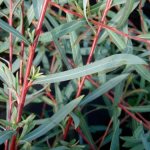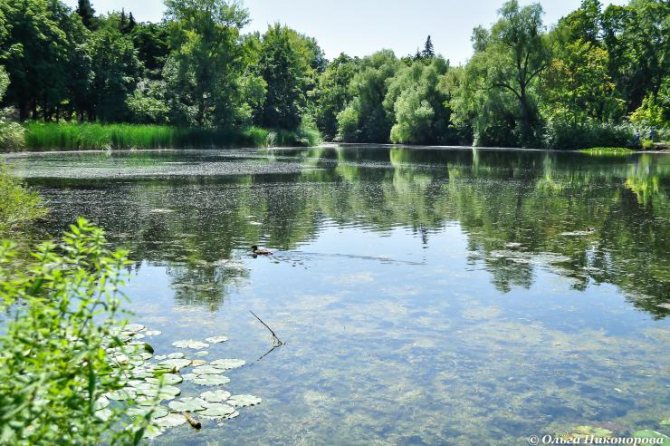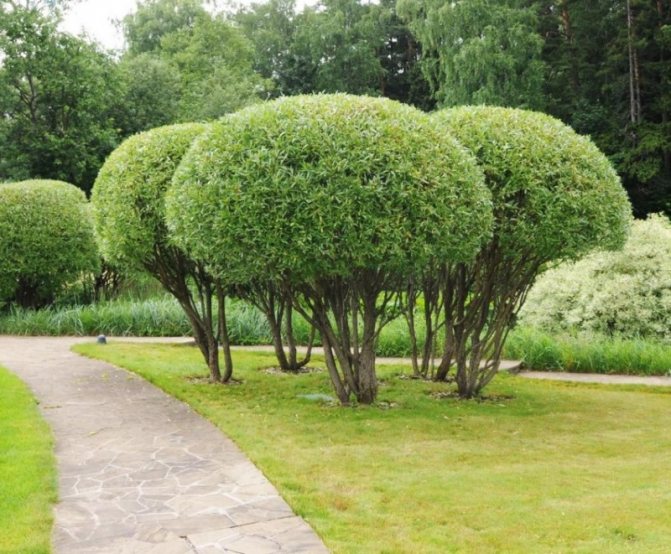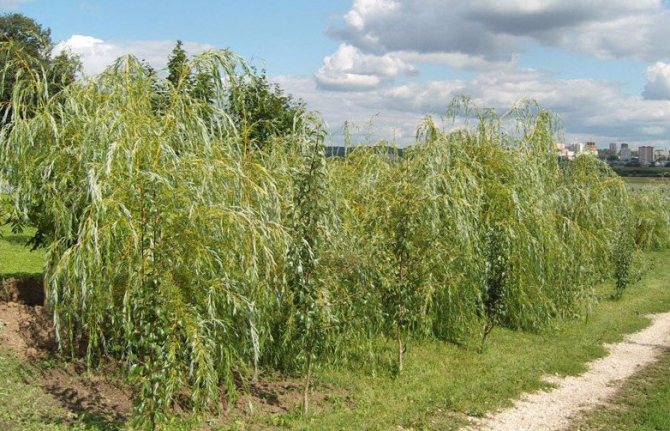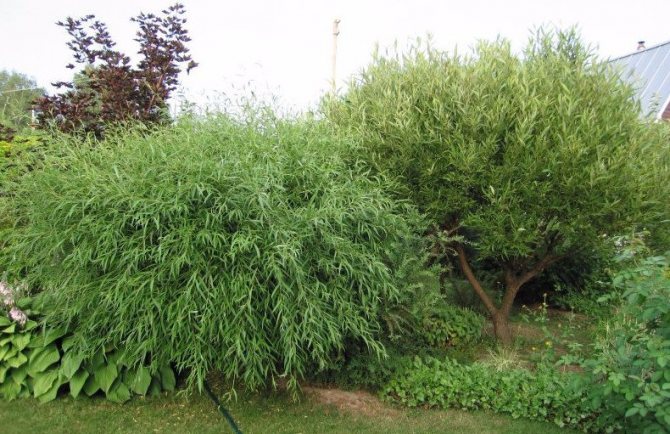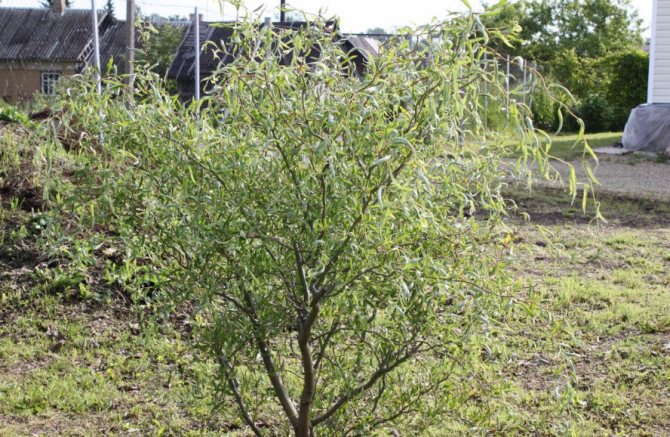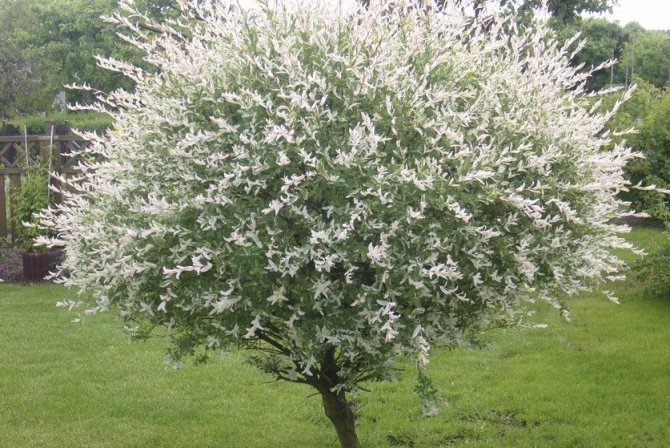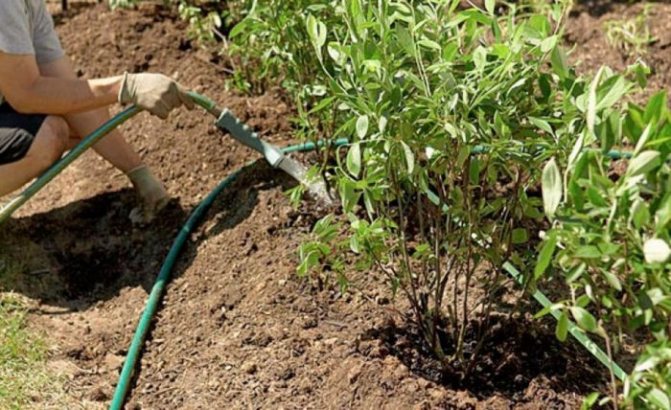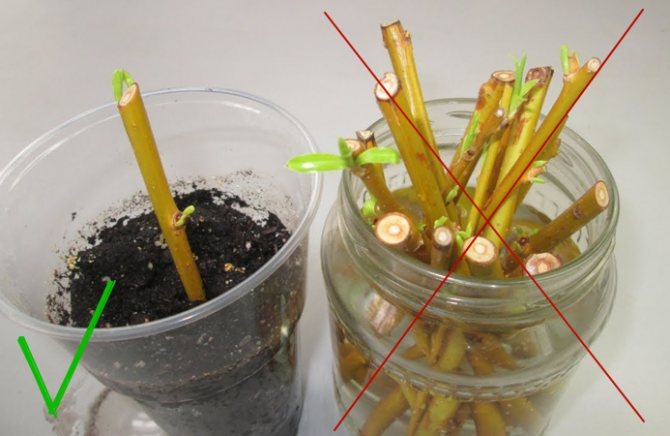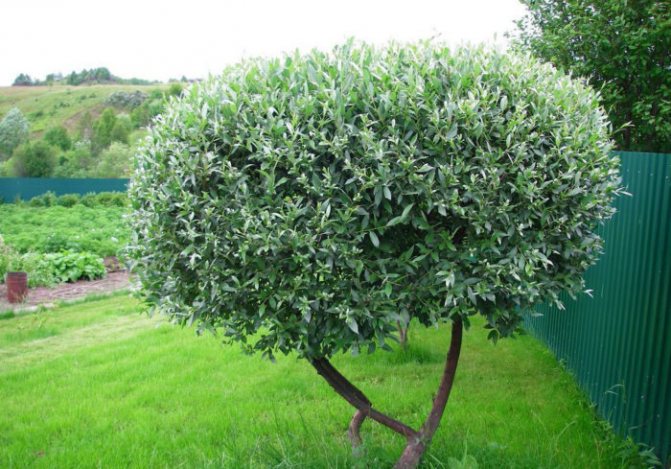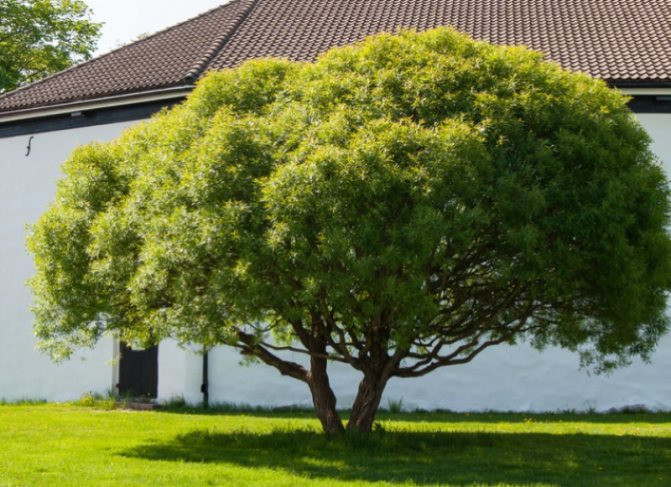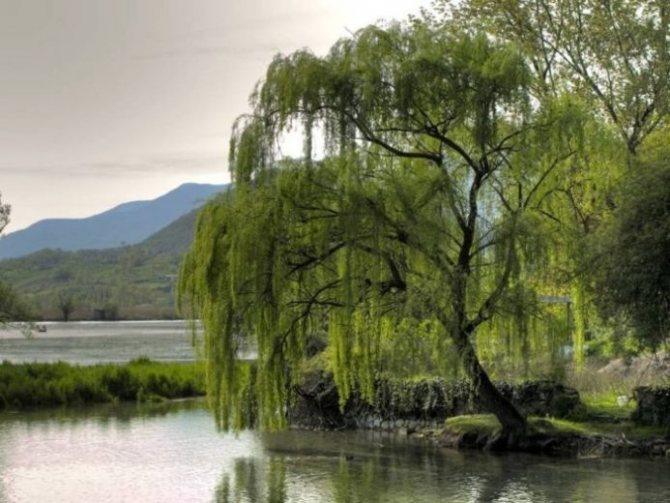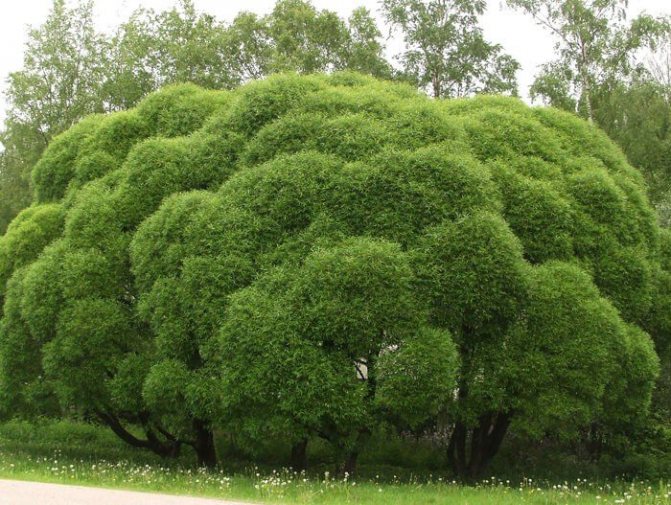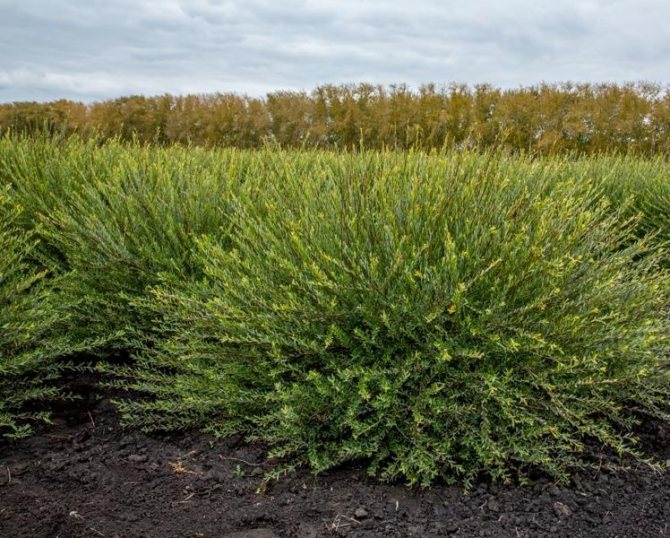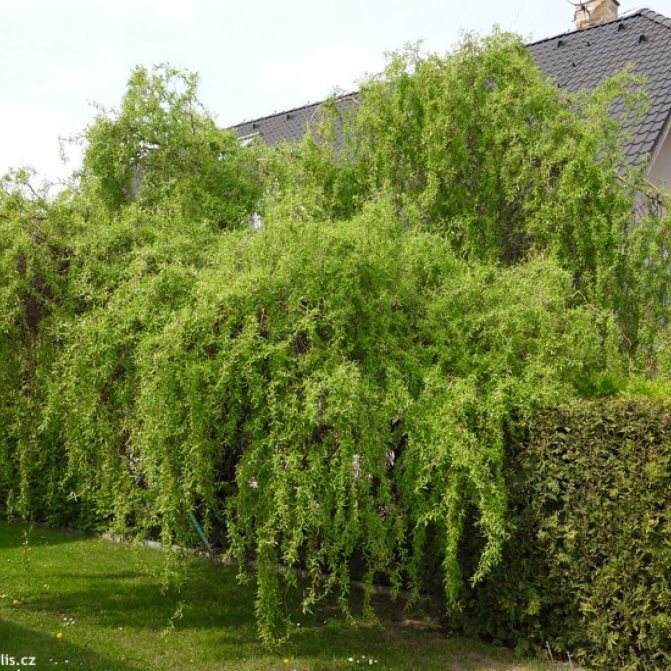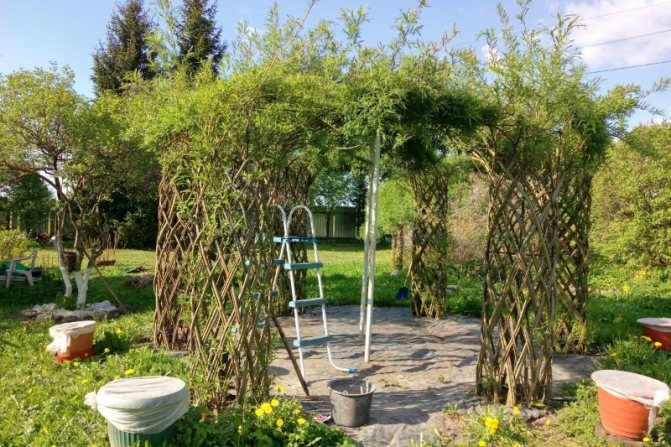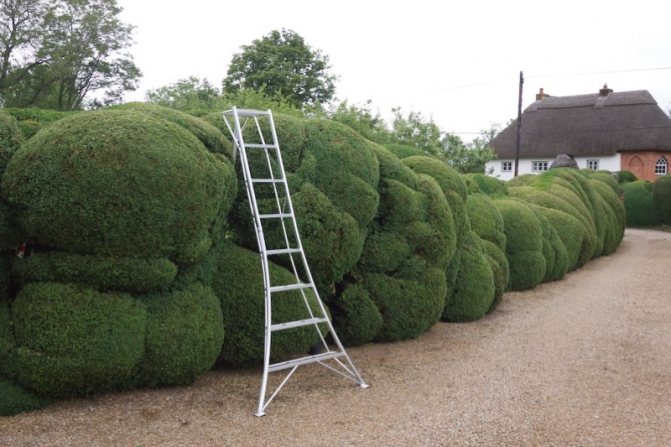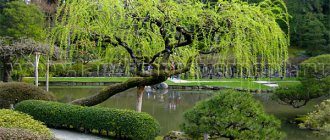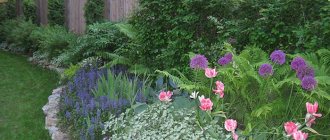Willow is a plant familiar to almost everyone, often used for landscaping areas. But specimens taken from the wild grow at a high rate, rapidly changing from thin twigs to large, if not giant, trees. Therefore, designers are increasingly paying attention to species and varieties with controlled growth, such as the willows of Hakuro Nishiki, which do not grow higher than 2 meters and look very impressive.
In general, the Willow genus is represented by a variety of natural forms - there are trees and shrubs, many-meter giants and almost midgets, species with erect, weeping or creeping shoots. And thanks to breeders, a wide variety of varieties and hybrids saw the light, among which you can find exactly what will suit a specific site and solve a specific problem.
Spherical willow: description, main varieties and varieties
The spherical willow is a unique tree that can grow into a small dwarf or become a real giant, reaching 15-20 m in height. It all depends on the characteristics of a particular variety. The external feature of any of the varieties of spherical willow is a luxurious rounded crown, which, thanks to densely growing leaves, turns into a beautiful green lush cap. In this case, the lower part of the branches and the trunk remain completely naked.
The spherical willow is an excellent honey plant, which is often planted near apiaries. In addition, willow can withstand the cold very well. Even at -40 ° C, it is able to survive. The plant is widespread not only in Russian territory, but also throughout the Eurasian continent and even in Africa and Australia. If we talk about the territory of Russia, then the following varieties of spherical willow are optimal for our open spaces (below the photo):
- Purple. This short shrub got its name due to the unusual color of flexible thin shoots and earrings - bright purple. The crown diameter reaches only 2 m.
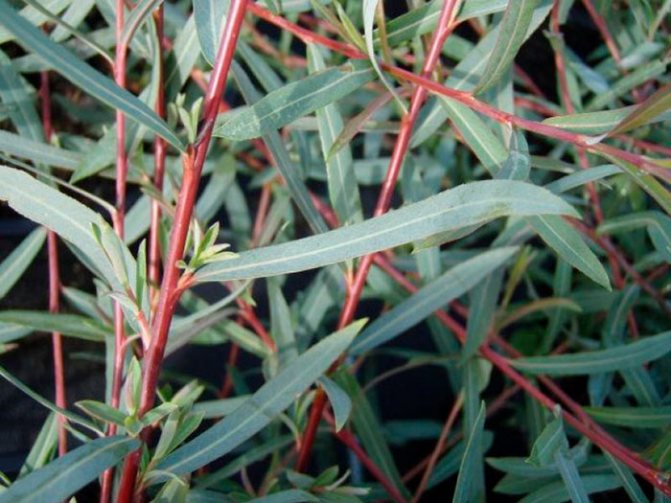
Purple willow
- Whole-leaved Hakuro Nishiki. Depending on the characteristics of the cultivation, the variety can look like a shrub or a full-fledged small tree with branches hanging down a little. The tips of the leaves of a young plant are distinguished by a bright pinkish-white color.
- Eared. Quite an impressive size shrub, characterized by a brownish shade of stems (young) and grayish branches.
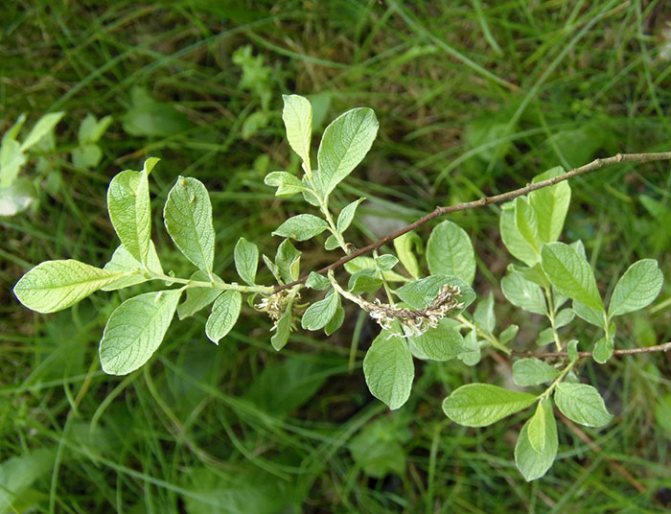

Eared willow
- Globular dwarf (hybrid). A very beautiful variety, represented by a small tree (about 2-3 m in height and width), characterized by a very dense and lush foliage crown.
- Sverdlovsk winding (hybrid). A tree of medium height, reaching 4-5 m. The crown is not very dense, drooping branches. The leaves are slightly curly.
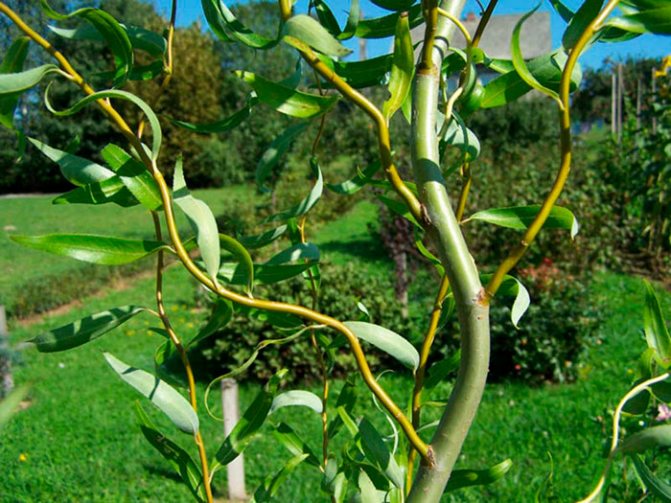

Sverdlovsk winding willow
- Lighthouse (hybrid). Was bred for weaving vines. It is currently represented by a beautiful lush spherical bush, reaching about 3 m in height.
Some interesting facts about the plant
The spherical willow not only has a beautiful decorative appearance, but is known for many useful properties. In the old days, a decoction from it was used to treat fever. And aspirin was extracted from the bark, without which it is impossible to imagine the life of a modern person.Also known are the healing properties of preparations based on willow for the prevention of cancer.
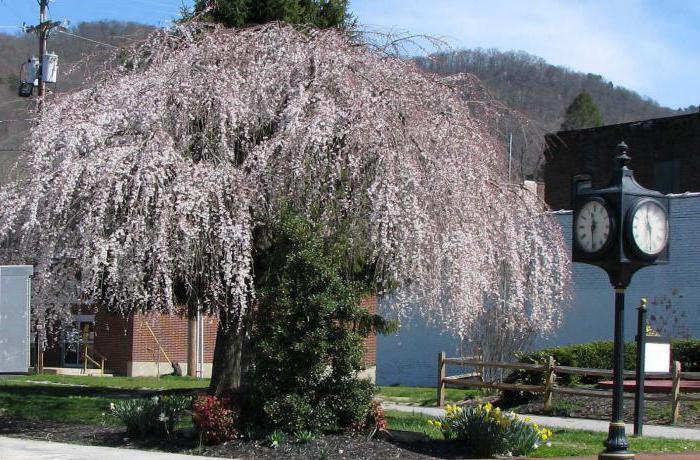

The bark and flexible branches of a tree have long been used for household needs, and to this day, wicker furniture is made from willow vines, and wood is used as a building material. The willow is the first to bloom in the spring, so the branches with its blossoming buds are used on Palm Sunday.
Due to its beauty and unpretentiousness, willow will become an exquisite decoration of any park or garden and will delight with its impeccable appearance all year round. In spring, this plant will delight you with lush and beautiful flowering, in summer it will give shade. In winter, the beauty of the shiny dark brown bark and the bizarre silhouette beneath a cap of snow will impress you.
Planting plants in open ground
The spherical willow differs from most plants not only in its unpretentiousness, but also in its excellent survival rate in those places where most of the plants will die. So, the spherical willow is very fond of moisture and will perfectly take root in places where groundwater accumulates. It's all about the incredible resistance of the willow root system to the effects of an excessively humid environment. Accordingly, willow roots will not rot even if there is standing water in the soil.
Since the willow is very fond of light, it is advisable to choose a light place for planting in open ground. Immediately before planting, prepare holes about 0.4 m deep and about 0.5 m wide. 1/3 of the hole is filled with a nutrient mixture consisting of compost, peat, nutrient soil. The period for planting willow is quite wide: planting seedlings in open ground can be carried out from mid-spring to mid-autumn. The main condition for a successful willow planting is not very dry roots and an earthen lump.
Planting seedlings
The spherical willow requires special rules for planting and caring for it. To begin with, it is almost impossible to plant this tree with the help of seeds, since they ripen in earrings that fall off at the slightest breath of wind and are suitable for planting only a couple of days after falling off. Therefore, the predominant method of planting is with the help of seedlings.
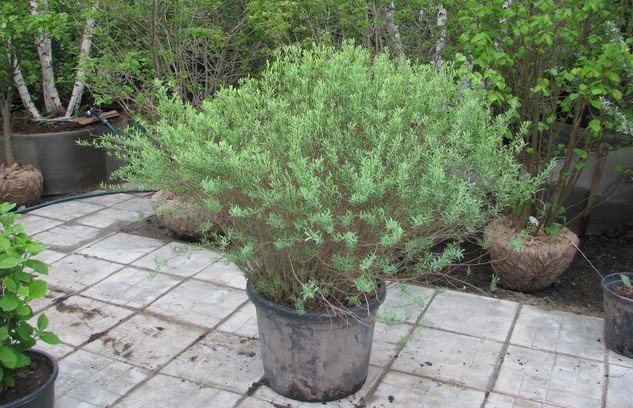

Timing
The most successful period for planting willow will be from April to mid-autumn. Planting later than the specified date can lead to unsuccessful wintering, as a result of which the seedlings will die.
rules
Before direct disembarkation, it is necessary to prepare the pits. They should be up to 50 cm in diameter and up to 30-40 cm deep. The bottom of the planting pit should be tamped with a prepared layer of nutritious soil, which you can make yourself by mixing peat, sand and compost in equal proportions.


Important! If you are planting from a peat pot, then you should not remove the seedling from it. Plant right with him - this will provide additional protection for the young tree.
If the plant will be planted from a plastic container, use the transshipment method, which implies planting with a clod of earth on the roots. The seedling must be immersed in the ground with several buds, which will contribute to better rooting of the willow in the future. If planting is done in mid-autumn, it is worth removing all the leaves, this will help the willow winter more successfully.
Spherical willow propagation
Reproduction of spherical willow is usually carried out by vegetative methods: cuttings or rooting in water. In the first case, it is necessary to carefully select the material for planting, which will certainly help you in a special nursery.


Globular willows in the nursery
The optimal breeding season for willows is early spring. Young shoots are cut (the lower cut should be oblique) about 30 cm long. Each should have at least 5 fully formed buds.
It is advisable to choose a place for planting with moist soil: a wetland or a site with a close occurrence of groundwater is ideal. A few hours before the start of reproduction, it is advisable to lower the young shoots into a solution with biostimulants in order to "wake up" the plants. After that, you can safely land in open ground.
If you bought planting material in the fall, you need to take care of its safety until spring. To do this, it is enough to carefully wrap the shoots with polyethylene and place them in a room with a cool, humid environment (a basement is perfect for these purposes).
When the plant is propagated by the second method, cuttings are cut in the spring, immediately before planting and placed in containers filled with water. Small cuts can be made at the bottom of each branch to stimulate root formation. As soon as the first roots grow on the cuttings, you can plant in a nutritious moist soil.
Creation of a willow garden
Globular willows, which are best propagated vegetatively, have gained a reputation as a plant that can take root even with one branch. The main condition is the presence of a sufficient amount of moisture. To get a tree with all the features of the variety, thanks to which you can easily form a crown, you will need annual cuttings. To create a hedge, it is better to take branches older than two years.
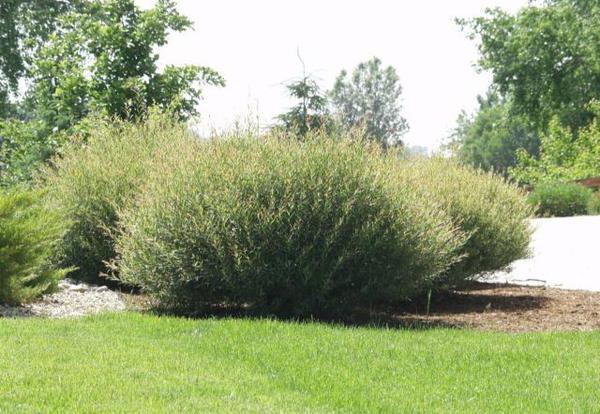

For reproduction, you need to cut branches immediately before rooting, 30 cm long. It is more expedient to carry out the procedure in the spring, in this case there will be no need to save the cuttings in the winter. There must be at least 5 buds on the workpiece. The upper cut must be made straight, and the lower cut oblique and under the kidney. You need to deepen the workpieces by 1/3 of the length. Particular attention should be paid to soil moisture, because willow is moisture-loving, and the shoots should not be allowed to dry out. Planting shoots near springs, wells or in wetlands is ideal.
Another method of reproduction is by rooting the plant in water. To do this, it is necessary to cut off the shoots at the beginning of the swelling of the buds and put them in a bowl of water. You can stimulate the process by making notches in the bark with a sharp knife. When the roots appear, it is necessary to transplant the cutting into a nutritious soil, preferably to a permanent place.
Features of tree care
Although willow is considered a rather unpretentious and very hardy tree, it, like any other plant, needs timely and full support from a gardener who grows it in the open field. Further about the features of willow care.
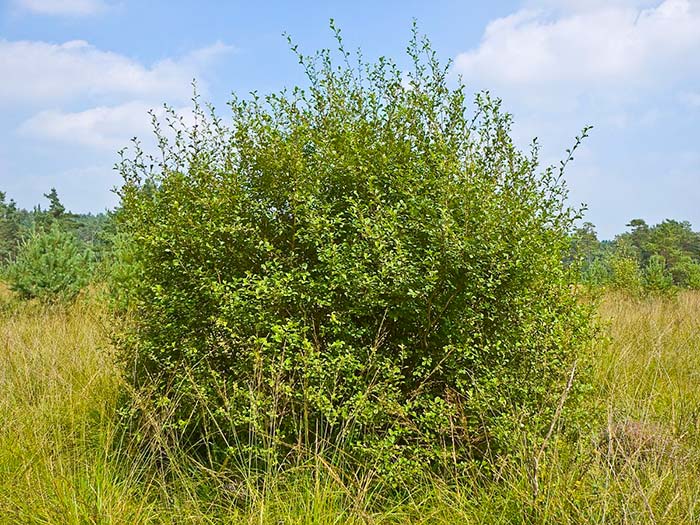

Willow needs to be fed at least 2 times a year.
Top dressing and irrigation regime
As noted earlier, the willow is very fond of moisture, respectively, the tree must be watered generously and often. Depending on the size of the tree, the volume of water should be about 20-50 liters (per tree). The watering procedure is carried out with a frequency of 2 times a month. In a very hot dry season, you can increase the frequency of watering up to 4 times a month.
Advice. If you want to simplify the care of the spherical willow and minimize the amount of watering, you just need to plant a young tree in an area flooded with groundwater. And then you can forget about moistening the soil in the area where the willow grows.
During the spring-autumn period, it is advisable to apply a complex mineral fertilizer at least a couple of times, and at the end of summer - also a nutritious organic complex. If by the end of the summer period gray-black dots with a bloom began to appear on the willow leaves, this is the first signal that the plant does not have enough copper: take care of immediate fertilization.
In autumn, all fallen leaves should be removed, if necessary, wild growth should be removed from the site. With the onset of cold weather, varieties unstable to low temperatures are necessarily "insulated" with breathable material.
Application in landscape design
Willows are a flexible material for landscaping. Various compositions, hedges and even topiary forms are all areas of its application. And the general unpretentiousness of the representatives of the genus Salix makes them practically indispensable in landscaping garden plots.
Willow hedge
A good alternative to a fence is a willow hedge, especially since it can be created in the shortest possible time. To create a hedge, shrub species are chosen, if a full-fledged fence is conceived, then it is better to choose medium-sized varieties, and dwarf varieties are perfect for decorative framing of paths.
The willow trellis hedge looks impressive, besides, it does not take up much space. To create it, cuttings or annual plants are used. They are planted in a row at a distance of 20-25 cm, but not vertically, but at an angle of 45⁰ - so that the twigs intersect with the neighboring ones and a diamond-shaped pattern is obtained. In places of contact, the bark of the seedlings is damaged with a sharp knife and fixed - due to this, the neighboring trunks grow together, which gives the hedge strength. As the branches grow, they intertwine further. A living trellis needs support.
The hedge should be periodically cut from the sides and top, shortening the young shoots. Usually, the thickness of such a plantation does not exceed 30 cm.
Low-growing breeds are planted along the paths or at the border of flower beds in a checkerboard pattern. Due to their rather rapid growth, the bushes soon merge into a single planting. Miniature willow curbs need a shaping and supportive haircut. Hedges also need watering, especially in dry, hot weather. And in order to achieve a special crown density, you can periodically feed the plantings with fertilizer with a high nitrogen content.
It will be useful to read:
Popular conifers for the garden Whatever the size of the plot, there will always be conifers for it, without which no garden can be considered ...
Landscape compositions
Due to its rapid growth and flexibility, willows are an excellent material for creating arches, green tunnels, and gazebos. For these purposes, young plants are planted in groups and intertwined as new shoots grow. Spherical forms, planted in small groups, look interesting in open spaces, as do undersized cushion shrubs.
Willow “Hakuro Nishiki” Lilies “Centranthus rube”, willow “Hakuro Nishiki”, black elderberry “Black Lace” Willow “Hakuro Nishiki” Iva “Hakuro Nishiki”, oriental poppy “Beauty of Livermere” and Allium “Globemaster”
Variegated varieties, for example, Japanese willow, go well with monotonously colored plants, and weeping and dwarf willows are almost irreplaceable in the design of streams and ponds on the site. Planting mixes of willows of different heights and outlines look peculiar. Almonds and other ornamental shrubs are good neighbors.
There can be many ideas for compositions and it all depends on the size of the site and the designer's imagination, and the variety of the willow species opens up more and more new possibilities for their use.
Disease and pest control
Unfortunately, willow is quite susceptible to various pests, so you should detect them in a timely manner and immediately begin to fight. The most dangerous and common willow pests include:
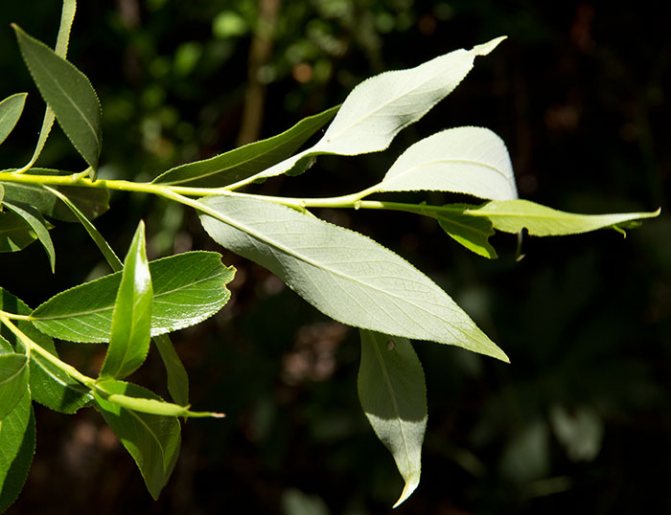

Willow is susceptible to disease, so carry out preventive treatment
- Willow weevil. The most dangerous willow pest that can destroy the entire willow garden. It actively lives and quickly destroys the plant. The result is huge, in some cases, passages that cover the willow, and then a sharp drop of foliage. The weevil is most active in August. Unfortunately, there is no pest control method.The only thing that can be done is to remove the damaged parts of the tree.
- Aphid. The pest known to many gardeners, unfortunately, is not by hearsay. Lives in large colonies attacking young willow shoots. As a result, the tops of the branches and the yellowness of the leaves are destroyed. Control method: kerosene-soap solution. About 2.5 liters of kerosene and 0.5 kg of green soap must be diluted in 75 liters of water. Spraying of the tree is carried out in the evening in the absence of strong winds.
- Willow cicada. Likes to make numerous egg clutches in willow shoots. The result is a cracked bark, an abundance of lateral shoots, drying of the main ones. The method of struggle is mechanical. Start with a generous amount of tar / glue on the willow branches. It remains only to wait for the pest and collect it by hand.
- Leaf beetle. Black, as if burnt leaves and partially bare branches - this is what the activity of the leaf beetle can lead to. Method of struggle: removing parts of the tree damaged by the pest and catching the beetle with bait in boxes lubricated with any adhesive.
How people use dwarf willow
The Japanese love bonsai because they can be grown in a regular flower pot. However, the growing procedure is very complicated.
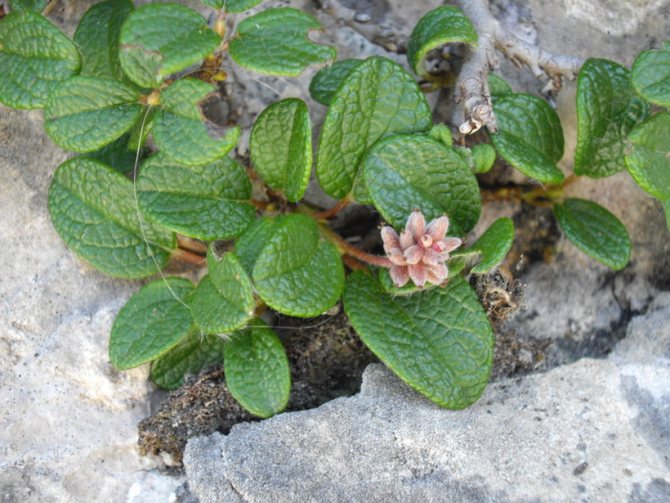

It will take a lot of time and effort. The process involves adherence to the "hilling" technology. The tree needs to cut the roots, form the crown, create depleted soil, water it to a limited extent, create the most close conditions. You will have to take care of the willow constantly:
- it is necessary to cut off old branches;
- pinch new layers;
- carefully cut off excess shoots;
- use other bonsai techniques.
Such a treatment for a dwarf willow becomes a real test. However, the cost per copy can be exorbitant. Only a few manage to achieve a high level of skill, therefore the work of craftsmen is highly valued.
Combining willow with other plants
Due to its original sophisticated appearance, the spherical willow is actively used as a decorative element in landscape design. The spherical willow is great for landscaping both parks and avenues, as well as private gardens.


Ball willow in landscape design
A spherical willow with proper care and proper placement among other plants in the garden can become a real work of art. The plant looks great in tandem with other shrubs.
It is often used in combination with bonsai when decorating Japanese-style gardens. It can be used as a single plant, because over time the branches of the tree become brittle and, falling down, create a lush original halo around the tree.
A wonderful decor can be obtained by growing spherical willow near water bodies. Ornamental stones are usually laid out in front of the tree, and the near-stem circle is decorated with soil flowers.
Advice. The globular willow is an excellent plant for strengthening slopes. Usually, for this purpose, varieties are planted with a crown height of at least 3 m.
That's all you need to know to successfully grow globular willow in any garden. Good luck!
Dwarf species - decoration of the park area
In modern landscape design, several varieties of this tree are especially popular, but the most common type is the brittle spherical willow, which is called broom. This tree can reach seven meters in height. The lush crown looks like a regular ball. The branches are quite fragile and can break from strong winds, but the fragility of the branches does not harm the aesthetic qualities of the tree, because thanks to the new growth, the splendor of the crown increases.
The dwarf spherical willow enjoys well-deserved popularity among landscape designers. The Purple Nana tree does not grow taller than one meter.Its dense crown is shaped like a regular ball. On flexible and thin branches, graceful and fine-pointed leaves grow. The plant will perfectly fit into any garden and will look especially attractive in spring, thanks to the purple color of the earrings.
Alternatives to the smallest tree in the world
Among the smallest trees in the world, not only grassy willow can be an excellent option for creating a rock garden. An ideal replacement is the small-fruited joster. The plant is characterized by miniature forms and thick, twisted trunks. Joster suits very well with light stones, on which he creates a contrast effect. The flowering period is characterized by the appearance of round fruits. The plant itself is inconspicuous and even inconspicuous. However, the joster complements the others well. Reproduction takes place with the help of seeds that need stratification. Like willow trees, the joster is resistant to cold weather. He needs to constantly receive sunlight and grow in normal humidity. Limestone soils will be quite suitable.
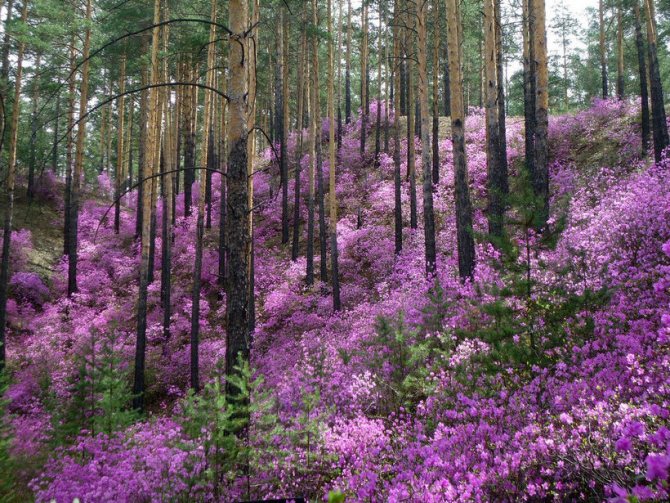

Among the smallest trees in the world, the small-leaved elm stands out. Its varieties Frosty and Hokkaido are great, but they are afraid of many diseases. They freeze out during winters, reproduce with difficulty. The situation is even worse for the Geisha variety, while such an elm more than compensates for its whimsical appearance with a spectacular look. Two-bladed ginkgo is suitable for landing on a slide. Recommended for landing at low heights. In winter it should be covered with snow, in spring it should be pruned.
Finally, attention can be drawn to the rhododendron. Of all the existing, the smallest in the world is the attractive rhododendron. All representatives can grow up to 80 centimeters, but an attractive rhododendron rarely exceeds 30 centimeters. Flowering occurs in May. An interesting color palette has become a feature of rhododendron. It can be light lilac and even bright purple. The flowers are neat, the bushes have a delightful dark green hue. Rhododendron prefers to grow on rocky soil, loves moisture, cool air. Group landing quite well.
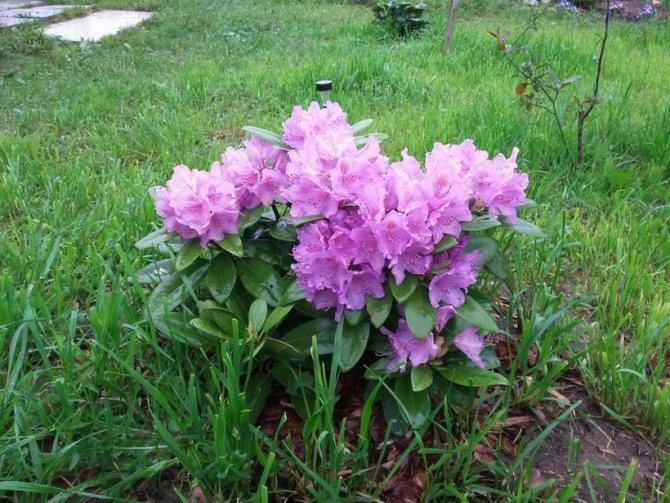

For a rock garden, a harsh-haired rhododendron is also suitable. The so-called pillows have become a characteristic feature of it, and the plant can grow up to 40 centimeters in height. It retains rich, dark green foliage all year round, preferring to stay in the shade. From time to time, the bush needs to receive sunlight, then it will grow more abundantly. The coarse-haired rhododendron, nicknamed the alpine rose, is unpretentious to soil conditions. Among the smallest trees in the world, the Caucasian rhododendron is considered the oldest. It is characterized by squat, dense branches, blooms with the onset of May. Beautiful white flowers are pleasing to the eye, but if a warm, lingering autumn comes out, then in spring the flowering will occur slowly. The Yakushiman variety, which was brought from Japan about 100 years ago, is very popular. But this variety can no longer be called dwarf, because it can grow up to 1 meter.
Nature gives us various miracles. Small, almost tiny trees, which find their refuge among the harshest conditions in the world, have become a clear proof of this and at the same time a real treasure of nature.

